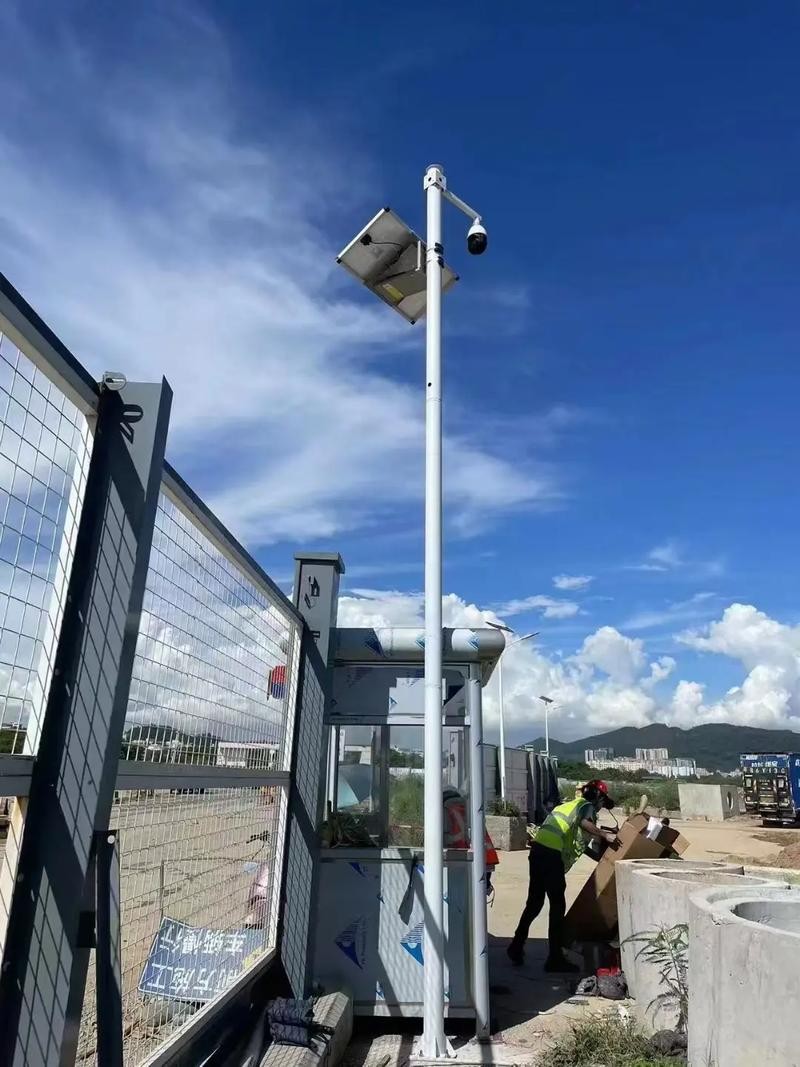Abstract
Amidst increasing complexity and safety demands on construction sites, particularly in large-scale infrastructure and energy projects, there is an urgent need for intelligent, autonomous monitoring solutions. This paper explores a fully off-grid, plug-and-play surveillance system that integrates 5G communication and solar energy. Designed to overcome challenges such as limited power availability, unstable network connections, and labor-intensive supervision, the system enables real-time, high-definition monitoring using AI-powered analytics and edge computing. It drastically reduces wiring costs, enhances safety management, and supports sustainable development initiatives across the construction and energy sectors.
0. Introduction: Digitalizing Construction Through Energy Innovation Jingning Thermal Power Co., Ltd. has pioneered a smart site supervision system tailored to high-risk, large-scale construction environments. Rooted in the principles of people-first safety management and long-term digital transformation, the system utilizes 5G for high-speed connectivity and photovoltaic solar technology for autonomous energy. This dual-core infrastructure enables agile camera deployment via mobile PTZ and pole-mounted units, supporting real-time data transmission, intelligent alerts, and cross-site visualization across remote command centers. By eliminating traditional barriers such as trenching for power and network cables, the smart construction site evolves into a fully wireless, low-carbon digital ecosystem.
1. Research Context: Challenges in Traditional Site Supervision Modern power plant construction projects face a trifecta of difficulties: manpower shortages, tight deadlines, and the need for accurate incident tracking. The lack of effective monitoring tools often leads to blind spots, delayed response, and regulatory non-compliance. Additionally, wired systems suffer from frequent cable damage, high installation costs, and insufficient scalability. These challenges underscore the urgency of adopting a modular, 5G-enabled, solar-powered monitoring framework that addresses safety, cost, and sustainability in a single architecture.
2. System Architecture: How 5G and Solar Energy Combine At the heart of the system lies the synergy between 5G cellular communication and solar-powered energy storage. Leveraging low-latency, high-bandwidth 5G networks, surveillance data from cameras and mobile PTZ units is transmitted securely to cloud-based platforms with near-zero delay. This ensures uninterrupted visibility into high-risk zones, enabling centralized supervision, predictive analytics, and collaborative decision-making.
Power is supplied by monocrystalline solar panels linked to intelligent LiFePO4 battery modules. These batteries offer up to five days of autonomy under cloudy conditions and support ultra-low temperature operation (-30℃ to 60℃). Intelligent charge/discharge cycles, BMS protection, and MPPT controllers further extend equipment lifespan and performance in variable environments.
3. Technical Features: Breaking the Barriers of Traditional Surveillance
3.1 Renewable Power and Carbon Offset The system achieves complete grid independence through clean energy harvesting. Each device reduces CO2 emissions by 1.2 tons annually and supports broader ESG targets. For clients operating under carbon audit frameworks, this solution enables verifiable sustainability reporting and measurable emissions reduction.
3.2 Wireless Deployment and 5G Roaming Capabilities The wireless architecture bypasses the need for trenching or ducting, allowing installation even in unstable soil or temporary structures. With support for private 5G slices or roaming across public 5G networks, the system offers seamless coverage regardless of terrain, mobility, or temporary relocation needs.
3.3 Durability, Modularity, and Edge Intelligence Each unit features IP66-rated enclosures, anti-corrosion aluminum frames, and surge-resistant components. Modular architecture allows users to scale up or down by simply swapping in additional cameras, storage modules, or AI processors. Edge AI supports face recognition, hard-hat detection, and unauthorized access alerts—all without cloud reliance.
3.4 AI Analytics and Data Traceability Using real-time behavioral analysis, the system can detect loitering, fights, over-crowding, or fall incidents. All footage is stored in redundant formats (local SSD + cloud backup) and encrypted to meet data compliance standards such as GDPR. QR-coded metadata tags allow fast historical review by timestamp, event, or personnel ID.
3.5 Installation Efficiency and Total Cost of Ownership (TCO) Deployment on existing poles, fences, or magnetic bases takes under 30 minutes, ideal for fast-changing sites. With zero monthly power bills and minimal maintenance, lifecycle cost is reduced by 60–70% compared to wired systems. The ROI is often realized within 12 months, especially on high-risk or multi-phase construction sites.
4. Field Applications: Engineering Safety Through Data and Autonomy

4.1 Risk Prevention in Live Construction Zones The system enables remote, continuous oversight of crane operations, trenching activities, and concrete pouring. Managers receive real-time alerts via mobile app or control room dashboard, empowering proactive interventions. Statistical data from pilot deployments shows a 75% drop in safety incidents when integrated into daily site routines.
4.2 Fully Wireless Site-Wide Coverage Unlike wired setups that are vulnerable to sabotage or accidental damage, this solution enables complete freedom in camera placement. Static cameras cover entry points and access control zones, while mobile PTZ units provide 360° views of evolving hot zones such as deep pits or scaffold structures.
4.3 Digital Record-Keeping and Engineering Forensics The system auto-captures video logs of milestone activities (e.g., concrete curing, steel placement) and archives them for future audits. Digital evidence of hidden work phases greatly enhances transparency and contractor accountability. It also supports drone integration for aerial inspection.
5. Conclusion: A Blueprint for Low-Carbon, High-Safety Construction The 5G solar surveillance system represents a leap in smart construction infrastructure. It brings together clean energy, digital communication, AI intelligence, and modular design to create a holistic monitoring solution tailored for tomorrow’s infrastructure sites. In an era of high scrutiny over safety, emissions, and digital compliance, this solution bridges technological innovation with real-world site resilience.
Its ability to operate entirely off-grid, adapt to variable terrains, and support intelligent decision-making makes it a cornerstone for future-ready construction practices. From fire-prone transmission projects to sprawling thermal plants, its utility extends across geographies and sectors.
Data Source: This research was inspired by and partially based on insights published via CNKI (China National Knowledge Infrastructure).
For technical inquiries or OEM cooperation, please visit our website at [www.kongfar.com](https://www.kongfar.com) or email us directly at tony@kongfar.com